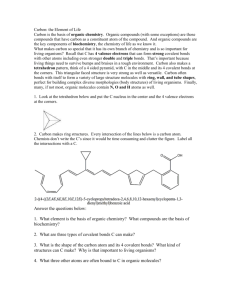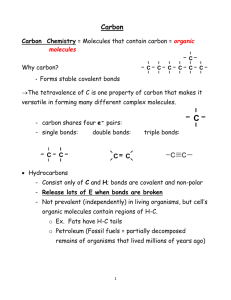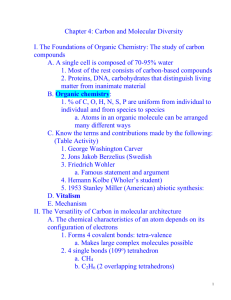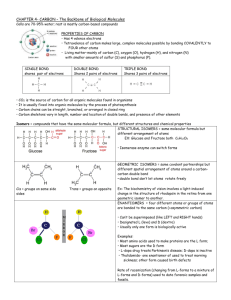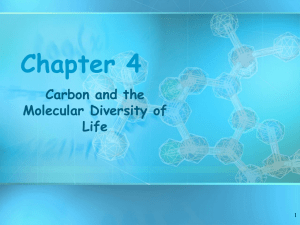Aside from water, most biologically important
advertisement
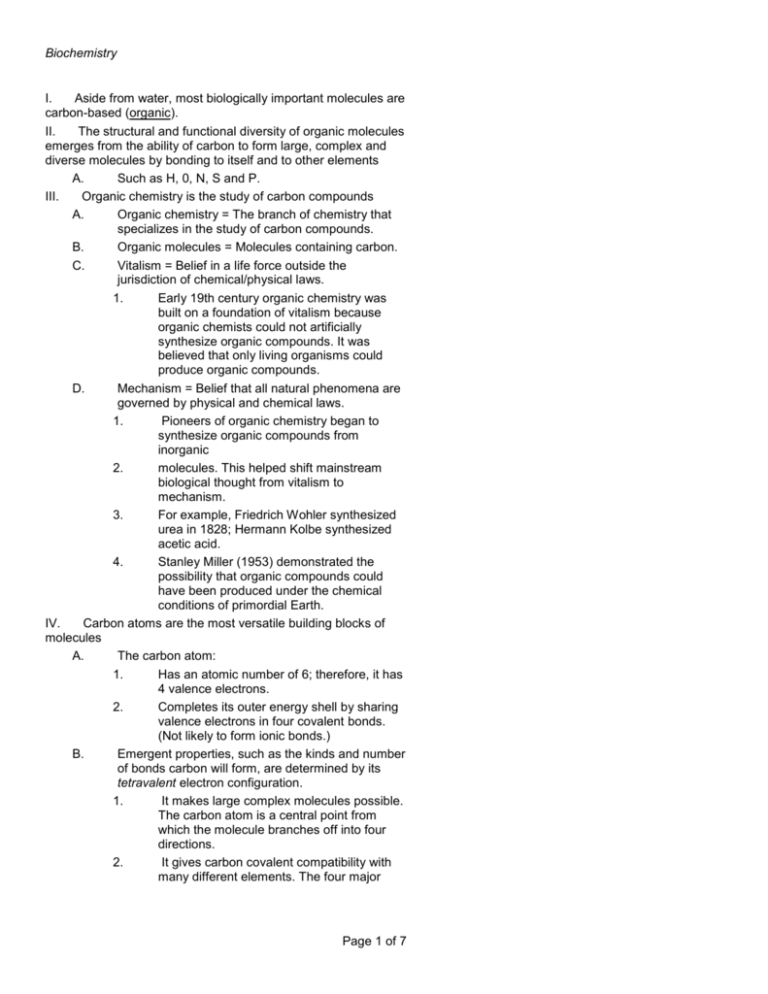
Biochemistry I. Aside from water, most biologically important molecules are carbon-based (organic). II. The structural and functional diversity of organic molecules emerges from the ability of carbon to form large, complex and diverse molecules by bonding to itself and to other elements A. Such as H, 0, N, S and P. III. Organic chemistry is the study of carbon compounds A. Organic chemistry = The branch of chemistry that specializes in the study of carbon compounds. B. Organic molecules = Molecules containing carbon. C. Vitalism = Belief in a life force outside the jurisdiction of chemical/physical laws. 1. Early 19th century organic chemistry was built on a foundation of vitalism because organic chemists could not artificially synthesize organic compounds. It was believed that only living organisms could produce organic compounds. D. Mechanism = Belief that all natural phenomena are governed by physical and chemical laws. 1. Pioneers of organic chemistry began to synthesize organic compounds from inorganic 2. molecules. This helped shift mainstream biological thought from vitalism to mechanism. 3. For example, Friedrich Wohler synthesized urea in 1828; Hermann Kolbe synthesized acetic acid. 4. Stanley Miller (1953) demonstrated the possibility that organic compounds could have been produced under the chemical conditions of primordial Earth. IV. Carbon atoms are the most versatile building blocks of molecules A. The carbon atom: 1. Has an atomic number of 6; therefore, it has 4 valence electrons. 2. Completes its outer energy shell by sharing valence electrons in four covalent bonds. (Not likely to form ionic bonds.) B. Emergent properties, such as the kinds and number of bonds carbon will form, are determined by its tetravalent electron configuration. 1. It makes large complex molecules possible. The carbon atom is a central point from which the molecule branches off into four directions. 2. It gives carbon covalent compatibility with many different elements. The four major Page 1 of 7 Biochemistry atomic components of organic molecules are: 3. It determines an organic molecule's 3-dimensional shape, which may affect molecular function. For example, when carbon forms four single covalent bonds, the four valence orbitals hybridize into teardropshaped orbitals that angle from the carbon atom towards the corners of an imaginary tetrahedron. V. Variation in carbon skeletons contributes to the diversity of organic molecules A. Covalent bonds link carbon atoms together in long chains that form the skeletal framework for organic molecules. These carbon skeletons may vary in: 1. Length. 2. Shape (straight chain, branched, ring). 3. Number and location of double bonds. 4. Other elements covalently bonded to available sites. B. This variation in carbon skeletons contributes to the complexity and diversity of organic molecules. (See Campbell, Figure 4.4) C. Hydrocarbons = Molecules containing only carbon and hydrogen 1. Are major components of fossil fuels produced from the organic remains of organisms living millions of years ago, though they are not prevalent in living organisms. 2. Have a diversity of carbon skeletons that produce molecules of various lengths and shapes. 3. As in hydrocarbons, a carbon skeleton is the framework for the large diverse organic molecules found in living organisms. Also, some biologically important molecules may have regions consisting of hydrocarbon chains (e.g. fats). 4. Hydrocarbon chains are hydrophobic because the C-C and C-H bonds are nonpolar. Page 2 of 7 Biochemistry D. Isomers = Compounds with the same molecular formula but with different structures and hence different properties. Isomers are a source of variation among organic molecules. 1. There are three types of isomers (See Campbell, Figure 4.6): a) Structural isomers = Isomers that differ in the covalent arrangement of their atoms. (1) b) Number of possible isomers increases as the carbon skeleton size increases. (2) May also differ in the location of double bonds. Geometric isomers = Isomers which share the same covalent partnerships, but differ in their spatial arrangements. (1) c) Result from the fact that double bonds will not allow the atoms they join to rotate freely about the axis of the bonds. (2) Subtle differences between isomers affects their biological activity. Enantiomers = Isomers that are mirror images of each other. Page 3 of 7 Biochemistry (1) Can occur when four different atoms or groups of atoms are bonded to the same carbon (asymmetric carbon). (2) There are two different spatial arrangements of the four groups around the asymmetric carbon. These arrangements are mirror images. (3) Usually one form is biologically active and its mirror image is not. VI. Functional groups also contribute to the molecular diversity of life A. Small characteristic groups of atoms (functional groups) are frequently bonded to the carbon skeleton of organic molecules. These functional groups: 1. Have specific chemical and physical properties. 2. Are the regions of organic molecules that are commonly chemically reactive. 3. Behave consistently from one organic molecule to another. 4. Depending upon their number and arrangement, determine unique chemical properties of organic molecules in which they occur. 5. As with hydrocarbons, diverse organic molecules found in living organisms have carbon skeletons. In fact, these molecules can be viewed as hydrocarbon derivatives with functional groups in place of H, bonded to carbon at various sites along the molecule. B. The Hydroxyl Group 1. Hydroxyl group = A functional group that consists of a hydrogen atom bonded to an oxygen atom, which in turn is bonded to carbon (-OH). a) Is a polar group; the bond between the oxygen and hydrogen is a polar covalent bond. b) Makes the molecule to which it is attached water-soluble. c) Polar water molecules are attracted to the polar hydroxyl group that can form hydrogen bonds. Page 4 of 7 Biochemistry d) C. The Carbonyl 1. Carbonyl group = Functional group that consists of a carbon atom double-bonded to oxygen (-CO). a) Is a polar group. The oxygen can be involved in hydrogen bonding, and molecules with his functional group are water-soluble. b) Is a functional group found in sugars. c) If the carbonyl is at the end off the carbon skeleton, the compound is an aldehyde. d) D. Organic compounds with hydroxyl groups are called alcohols. If the carbonyl is not at the end of the carbon skeleton, the compound is a ketone. The Carboxyl Group 1. Carboxyl group = Functional group that consists of a carbon atom which is both double-bonded to an oxygen and singlebonded to the oxygen of a hydroxyl group (COOH). a) Is a polar group and water-soluble. The covalent bond between oxygen and hydrogen is so polar, that the hydrogen reversibly dissociates as H+. This polarity results from the combined effect of the two electronegative oxygen atoms bonded to the same carbon. Page 5 of 7 Biochemistry b) Since it donates protons, this group has acidic properties. Compounds with this functional group are called carboxylic acids. E. The Amino Group 1. Animo group = Functional group that consists of a nitrogen atom bonded to two hydrogens and to the carbon skeleton (NH2). a) Is a polar group and soluble in water. b) Acts as a weak base. The unshared pair of electrons on the nitrogen can accept a proton, giving the amino group a +1 charge. c) F. G. Organic compounds with this function group are called amines. The Sulfhydryl Group 1. Sulfhydryl group = Functional group which consists of an atom of sulfur bonded to an atom of hydrogen (-SH). a) Help stabilize the structure of proteins. (Disulfide bridges will be discussed with tertiary structure of proteins in Chapter 5: Structure and Function of Macromolecules.) b) Organic compounds with this functional group are called thiols. The Phosphate Group 1. Phosphate group = Functional group which is the dissociated form of phosphoric acid (H3PO4) a) Loss of two protons by dissociation leaves the phosphate group with a negative charge. Page 6 of 7 Biochemistry b) c) Has acid properties since it loses protons. Polar group and soluble in water. Organic phosphates are important in cellular energy storage and transfer. Page 7 of 7

